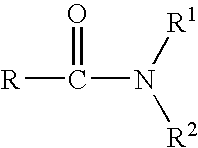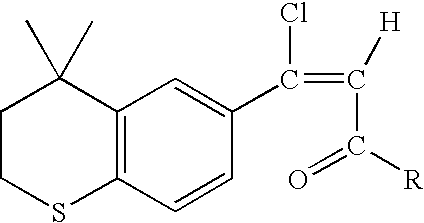Process for the preparation of 4,4-dimethyl-6-ethynylthiochroman
a technology of thiochroman and dimethyl thiochroman, which is applied in the field of improving the process for the preparation of the intermediate 4, 4dimethyl6ethynylthiochroman, can solve the problems of difficult to handle on a commercial scale, difficult to use reagents, high toxic and corrosive diethyl chlorophosphate, etc., and achieves the effect of difficult to handl
- Summary
- Abstract
- Description
- Claims
- Application Information
AI Technical Summary
Benefits of technology
Problems solved by technology
Method used
Image
Examples
example 1
Preparation of 3-[4,4-dimethylthiochroman-6-yl]-3-chloro-2-propene-1-al
In a 500 ml 4-necked round bottom flask fitted with a mechanical stirrer and a reflux condenser, 6-acetyl-4,4-dimethylthio-chroman (22 g) and dimethylformamide (38 ml) are added at a temperature in the range of from about 35° C. to about 95° C. under stirring. The reaction mixture is then cooled to a temperature in the range of from about −5° C. to about 0° C. Phosphorus oxychloride (17.2 g) is added to the reaction mixture dropwise over about 30 minutes. Following the addition of the phosphorous oxychloride, the reaction mixture is maintained at a temperature in the range of from about 10° C. to about 15° C. for about 8 hours to about 10 hours. After completion of the reaction as determined by TLC, the reaction mixture is added to cold water (100 ml) at a temperature of from about 0° C. to about 5° C. containing sodium acetate (25 g). The aqueous layer is extracted with dichloromethane (200 ml×3). The organic ...
example 2
Preparation of phenyl-3-methylbut-2-enyl sulfide
In a 5L 4-neck round bottom flask, methanol (1400 ml) and thiophenol (200 g) were added under stirring at a temperature ranging from about 25° C. to about 35° C. Sodium hydroxide (powder LR grade) (73.60 g) and methanol (100 ml) were added under stirring. The reaction mixture was left under a nitrogen atmosphere and stirred at room temperature (about 25° C. to about 30° C.) for an hour. 1-bromo-3-methyl-2-butene (274 gm) was added to the reaction mixture and it was observed that the temperature rose to about 40° C. The reaction mixture was heated to reflux and maintained for about 12 hours. After completion of the reaction as determined by HPLC, the methanol was distilled out from reaction mixture under vacuum at a temperature below 60° C. Ethylene dichloride (1500 ml) and water (1000 ml) were added to the residue. The organic layer was separated and washed with a 5% sodium hydroxide (600 ml) solution, and then water (3×600 ml) until...
PUM
 Login to View More
Login to View More Abstract
Description
Claims
Application Information
 Login to View More
Login to View More - R&D
- Intellectual Property
- Life Sciences
- Materials
- Tech Scout
- Unparalleled Data Quality
- Higher Quality Content
- 60% Fewer Hallucinations
Browse by: Latest US Patents, China's latest patents, Technical Efficacy Thesaurus, Application Domain, Technology Topic, Popular Technical Reports.
© 2025 PatSnap. All rights reserved.Legal|Privacy policy|Modern Slavery Act Transparency Statement|Sitemap|About US| Contact US: help@patsnap.com



